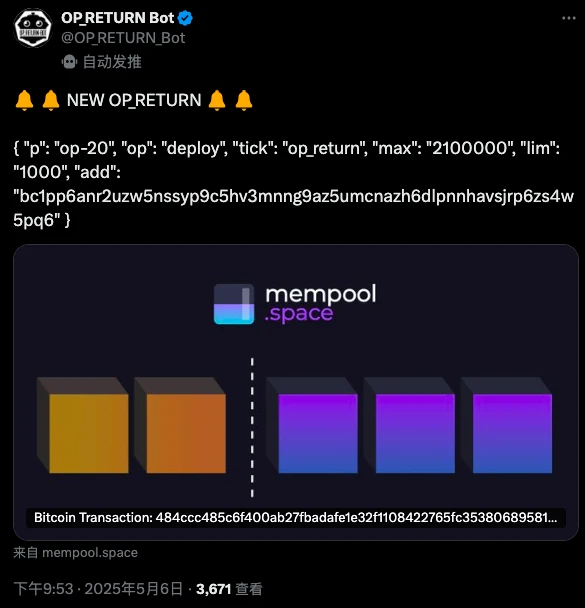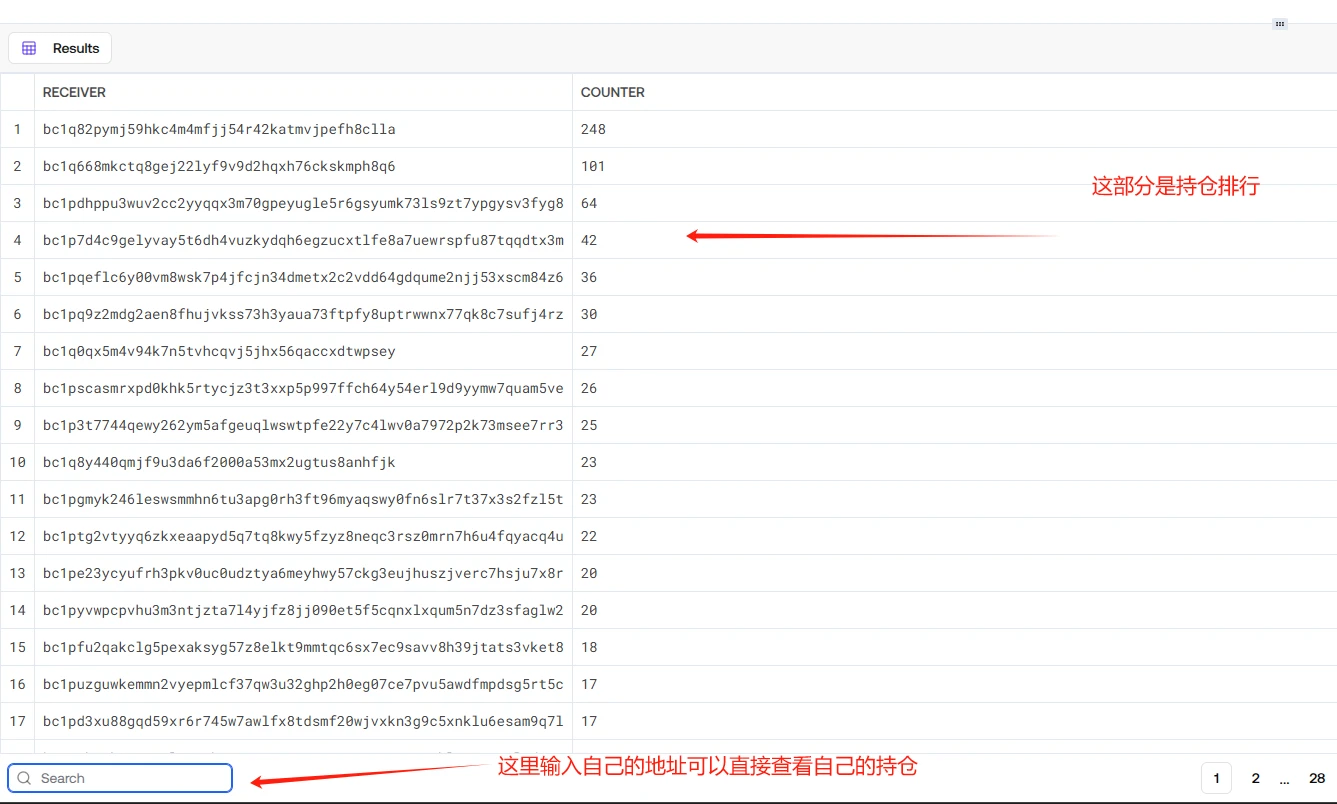Original | Odaily Planet Daily (@OdailyChina_)
_

Is the sleeping lion about to awaken? This is the sentiment of some deep players in the Bitcoin ecosystem recently.
A developer statement on May 6 indicated that the next version of Bitcoin Core may abolish the limit that OPRETURN outputs cannot exceed 80 bytes. The statement noted that the 80-byte cap on OPRETURN is no longer suitable for current needs; it is easily bypassed, as some private mining accelerators do not enforce these limits at all; and it creates distorted incentive mechanisms, where some projects incentivize certain private services to circumvent the restrictions. The statement also claimed that the abolition of the 80-byte limit on OP_RETURN has received widespread support.
Currently, a new token deployment format called OP-20 has emerged in the market, which breaks the 80-byte limit of OPRETURN. The OTC transaction price of the token named opreturn has risen to $400 each (with one unit being 1000 tokens), while the cost is only $5-6 each.
Odaily Planet Daily will briefly introduce what OP_RETURN is, the pros and cons of the Bitcoin network after a successful upgrade, and the prospects of issuing OP-20 using this mechanism.
Debate Surrounding OP_RETURN
In the Bitcoin network, OPRETURN is an opcode specifically used to carry arbitrary data in transactions. The data carried by OPRETURN outputs will not be referenced by subsequent transactions and will not occupy the UTXO space of nodes.
In the early days, Bitcoin nodes had to permanently retain all unspent outputs (UTXO), and malicious or indiscriminate data writing could cause storage pressure on nodes. Therefore, in 2013, the community proposed the idea of adding an immediately invalid script to "lighten" data storage. Subsequently, in 2014, Bitcoin Core version 0.9.0 officially included OP_RETURN outputs as a "standard output" type and set the data limit to 40 bytes, which was later gradually increased to 80 bytes to balance the demand for data writing and the protection of network resources.
OP_RETURN Limit No Longer Meets the Development Needs of the Bitcoin Ecosystem
Thus, the original purpose of Bitcoin developers in designing OPRETURN was to prevent nodes from excessively inflating storage by processing scripts containing large amounts of data, using it as a "lightweight record" function for the blockchain. However, as the Bitcoin ecosystem has developed, various asset protocols, project parties, L2, and cross-chain bridges have needed to record more and more data on-chain, making the 80-byte limit of OPRETURN increasingly restrictive.
To meet project needs, various project parties have had to find ways to circumvent this limitation, including offering high rewards to miners. This is why Bitcoin Core core contributor Greg Sanders published a statement on GitHub proposing to remove the 80-byte limit in the next version of Bitcoin Core, allowing for OP_RETURN outputs of any quantity and length.
He believes that the removal of the 80-byte limit will bring at least the following two tangible benefits:
A cleaner UTXO set. Data can now be placed in an output that is provably unspendable, rather than disguised in spendable scripts or scattered across multiple transactions.
Consistency of behavior. Nodes can relay transactions that miners want to see, making fee estimation and compact block relaying more reliable.
Opposition Remains Strong
However, in reality, Bitcoin Core has not yet announced a specific date for the next upgrade. Meanwhile, there are still many opposing voices under the GitHub statement regarding the upgrade.
Community member wizkid057 stated that this is far more than a minor technical change; it is a fundamental change to the essence of the entire Bitcoin network. The Bitcoin network will become an arbitrary data storage system rather than developing as a decentralized currency. It will also lead to an increase in data-intensive protocols (such as inscriptions, NFTs) and "garbage" data.
Upgrade Not Yet Achieved, Token Issued First
Despite the lack of a conclusion on the update to abolish the 80-byte limit on OPRETURN in the next version of Bitcoin Core, a token deployment standard that breaks this limit, OP-20, has quietly gone live, and the first token opreturn is suspected to have been fully minted, with the current OTC transaction price reaching $400 each (with one unit being 1000 tokens), while the initial cost was only $5-6 each, achieving a hundredfold "floating profit."

The op_return is suspected to have been deployed by the address bc1p…4w5pq6 on the evening of May 6 evening, with a total of 2.1 million, comprising 2100 units. As shown in the Bot push, its token deployment format is not fundamentally different from BRC-20, except that it includes an address in the JSON text (which may also be the reason OP-20 exceeds the 80-byte limit).

Thus, the format for minting op_return is as follows:
{ "p": "op-20", "op": "mint", "tick": "op_return", "amt": "1000", "add": "this is your Bitcoin address" }
Users paste this text information into the OPRETURN Bot website, and then pay via the Lightning Network to create an OPRETURN output to complete the minting operation. Currently, the community speculates that op_return has been fully minted, but there is no official index or transaction transfer tool available, and only OTC double betting can be conducted.
Regarding the indexing rules (which determine whether you have minted or not), a community player has listed two scenarios: one does not allow batch minting (i.e., multiple mints in one transaction) index, while the other allows batch indexing.
 Additionally, some community players have compared OP-20 with BRC-20, arguing that OP-20 does not have concerns about block size inflation and UTXO pollution, making it clearly superior to BRC-20. However, it should be noted that Bitcoin Core has not yet abolished the 80-byte limit on OPRETURN, so OP-20 cannot, in principle, be packaged on-chain; users can only wait for mining pools like MARA and f2pool that may have lifted the 80-byte limit on OPRETURN to process transactions on-chain.
Additionally, some community players have compared OP-20 with BRC-20, arguing that OP-20 does not have concerns about block size inflation and UTXO pollution, making it clearly superior to BRC-20. However, it should be noted that Bitcoin Core has not yet abolished the 80-byte limit on OPRETURN, so OP-20 cannot, in principle, be packaged on-chain; users can only wait for mining pools like MARA and f2pool that may have lifted the 80-byte limit on OPRETURN to process transactions on-chain.
In reality, although interest has waned, there remains a group of dedicated community developers and players actively engaged in the Bitcoin ecosystem. Innovations such as Odin.Fun and Alkanes protocol have emerged recently, but ultimately they have not escaped the fate of being all noise and little action. So, the age-old question remains: relying on the anticipated upgrade of Bitcoin Core, can OP-20 lead the Bitcoin ecosystem to rise? We shall wait and see.
免责声明:本文章仅代表作者个人观点,不代表本平台的立场和观点。本文章仅供信息分享,不构成对任何人的任何投资建议。用户与作者之间的任何争议,与本平台无关。如网页中刊载的文章或图片涉及侵权,请提供相关的权利证明和身份证明发送邮件到support@aicoin.com,本平台相关工作人员将会进行核查。




